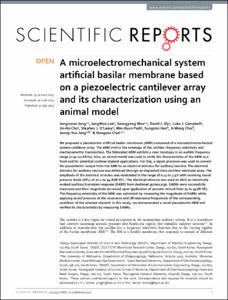Department of Electrical Engineering and Computer Science
CSP(Communication and Signal Processing) Lab
1. Journal Articles
Full metadata record
| DC Field | Value | Language |
|---|---|---|
| dc.contributor.author | Jang, Jongmoon | - |
| dc.contributor.author | Lee, JangWoo | - |
| dc.contributor.author | Woo, Seongyong | - |
| dc.contributor.author | Sly, David J. | - |
| dc.contributor.author | Campbell, Luke J. | - |
| dc.contributor.author | Cho, Jin-Ho | - |
| dc.contributor.author | O'Leary, Stephen J. | - |
| dc.contributor.author | Park, Min-Hyun | - |
| dc.contributor.author | Han, Sungmin | - |
| dc.contributor.author | Choi, Ji-Wong | - |
| dc.contributor.author | Jang, Jeong Hun | - |
| dc.contributor.author | Choi, Hongsoo | - |
| dc.date.available | 2017-05-11T01:36:17Z | - |
| dc.date.created | 2017-04-10 | - |
| dc.date.issued | 2015-07 | - |
| dc.identifier.issn | 2045-2322 | - |
| dc.identifier.uri | http://hdl.handle.net/20.500.11750/1569 | - |
| dc.description.abstract | We proposed a piezoelectric artificial basilar membrane (ABM) composed of a microelectromechanical system cantilever array. The ABM mimics the tonotopy of the cochlea: frequency selectivity and mechanoelectric transduction. The fabricated ABM exhibits a clear tonotopy in an audible frequency range (2.92-12.6 €‰kHz). Also, an animal model was used to verify the characteristics of the ABM as a front end for potential cochlear implant applications. For this, a signal processor was used to convert the piezoelectric output from the ABM to an electrical stimulus for auditory neurons. The electrical stimulus for auditory neurons was delivered through an implanted intra-cochlear electrode array. The amplitude of the electrical stimulus was modulated in the range of 0.15 to 3.5 €‰V with incoming sound pressure levels (SPL) of 70.1 to 94.8 €‰dB SPL. The electrical stimulus was used to elicit an electrically evoked auditory brainstem response (EABR) from deafened Guinea pigs. EABRs were successfully measured and their magnitude increased upon application of acoustic stimuli from 75 to 95 €‰dB SPL. The frequency selectivity of the ABM was estimated by measuring the magnitude of EABRs while applying sound pressure at the resonance and off-resonance frequencies of the corresponding cantilever of the selected channel. In this study, we demonstrated a novel piezoelectric ABM and verified its characteristics by measuring EABRs. | - |
| dc.publisher | NATURE PUBLISHING GROUP | - |
| dc.title | A microelectromechanical system artificial basilar membrane based on a piezoelectric cantilever array and its characterization using an animal model | - |
| dc.type | Article | - |
| dc.identifier.doi | 10.1038/srep12447 | - |
| dc.identifier.scopusid | 2-s2.0-84938614503 | - |
| dc.identifier.bibliographicCitation | Scientific Reports, v.5 | - |
| dc.description.isOpenAccess | FALSE | - |
| dc.subject.keywordPlus | Acoustic Sensor | - |
| dc.subject.keywordPlus | AUDITORY-NERVE | - |
| dc.subject.keywordPlus | BEAM ARRAYS | - |
| dc.subject.keywordPlus | Cochlear Implant | - |
| dc.subject.keywordPlus | DIAPHRAGM | - |
| dc.subject.keywordPlus | FREQUENCY-SELECTIVITY | - |
| dc.subject.keywordPlus | INNER-EAR | - |
| dc.subject.keywordPlus | PHYSICAL MODEL | - |
| dc.subject.keywordPlus | SPIRAL GANGLION-CELLS | - |
| dc.subject.keywordPlus | STIMULATION | - |
| dc.citation.title | Scientific Reports | - |
| dc.citation.volume | 5 | - |
- Files in This Item:
-
 기타 데이터 / 1.58 MB / Adobe PDF
download
기타 데이터 / 1.58 MB / Adobe PDF
download



